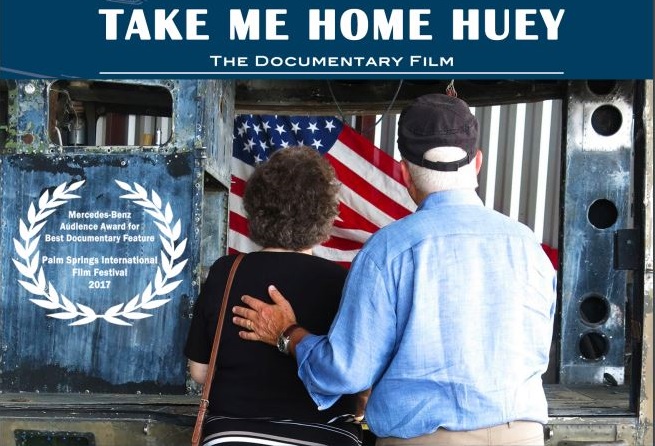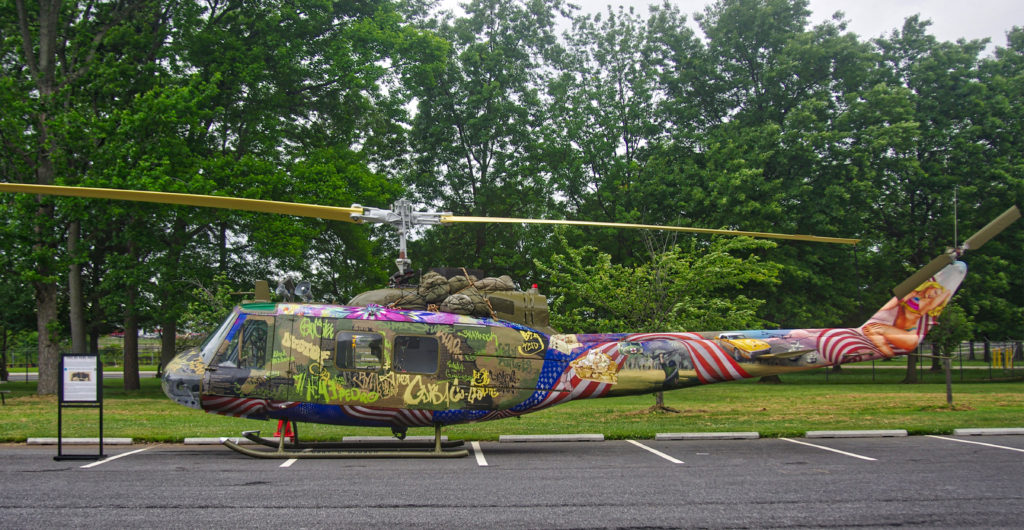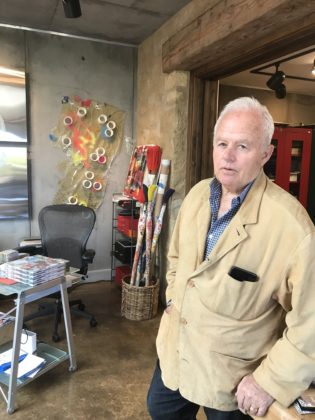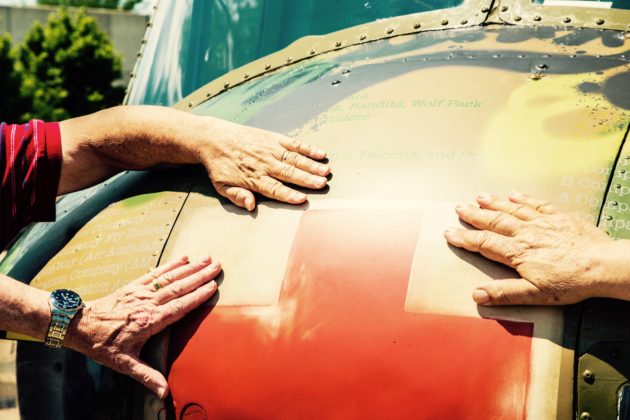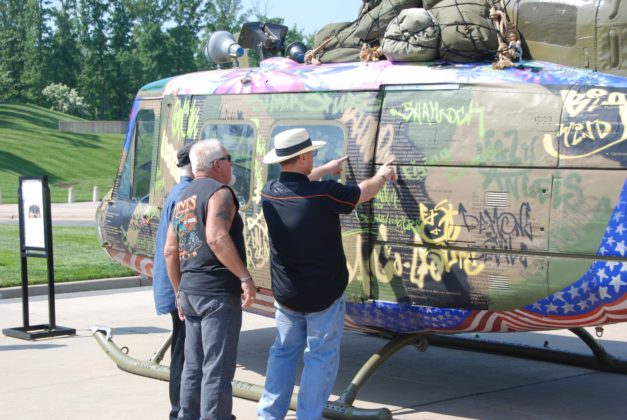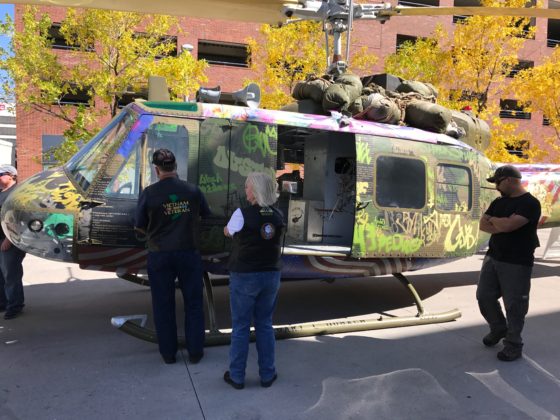Take Me Home Huey, a documentary by contemporary artist Steve Maloney, will be shown at the Coronado Island Film Festival over Veterans Day weekend. Take Me Home Huey made its World Premiere at the Palm Springs International Film Festival in January 2017, and won the Mercedes-Benz Audience Award for Best Documentary. The film was produced by Maloney along with film-makers Alicia H. Braun and Christine N. Steele.
The 70-minute film documents both the role of the Huey helicopter in Vietnam and the restoration of a particular Huey helicopter and its transformation into a piece of art meant to bring attention to those who suffer from Post Traumatic Stress (PTS). The film also highlights the power of art to heal.
Take Me Home Huey is more than the documentary – it is an entire art installation, consisting of the documentary, a genuine, restored, Vietnam War Huey helicopter, now turned into a sculpture, and a specially-commissioned song by producer, singer, and songwriter, Jeanie Cunningham.
Since November of 2015 the installation has been on tour, traveling from one coast to another, taking in spots from New York to Los Angeles and from St. Paul to St. Louis and many in between. All elements of the installation will come together in Coronado on Veterans Day Weekend this year. The film will be shown on Saturday, November 11 at 4pm and at 7pm in the CoSA Main Stage Theatre at Coronado High School (The Coronado Performing Arts Center). Each showing will end with Jeanie Cunningham performing the theme song. Huey, the helicopter, will be on view outside the theater after the shows. Many others involved in the making of the installation will be available that weekend as well, including the artist and filmmakers.
The Artist
The story of Take Me Home Huey starts with the artist, Steve Maloney. Maloney was born in Kalamazoo, Michigan and now resides in Rancho Santa Fe, California. But, along the way, Maloney was educated in Lugano, Switzerland and became a manufacturer of industrial metal tools. He then studied art. This varied background has all contributed to the art that Maloney creates today and the specific installation that will be visiting Coronado.
Maloney is a contemporary artist who works across art forms, creating both sculptures as well as paintings. Maloney’s work often contains “found” objects. One prior exhibition, This is Where the Rubber Meets the Road, used pieces of wrecked NASCAR sheet metal to create 28 sculptures. Another series of sculptures entitled Banned Booty included items confiscated at airports by TSA, and includes sculptures made of scissors. In his studio in Rancho Santa Fe, light glints off of the scissors of a hanging sculpture, highlighting the almost playful nature of his work.
Maloney’s inspiration for Take Me Home Huey was a call by President Obama to Commemorate the 50th anniversary of the Vietnam War. Maloney pointed out that this work marked a serious turn for him – to create a memorial piece rather than the more whimsical pieces that had preceded it. Maloney wanted to do it though, because he felt it was important to “welcome back those who never got a proper welcome back,” and to bring attention to veterans suffering from PTS.
The Mission – Thanking Those Who Served
The documentary, which shows the creation of the sculpture and tells the history of the particular Huey that Maloney worked on, also tells the story of many of those who served in Vietnam. It is a sad story for so many of them.
2.7 million Americans served in Vietnam and 58,000 were killed. The rest came home to face a great deal of the public criticism for the war. Contrary to the experience of most veterans from prior wars who had been welcomed home as heroes, Vietnam War vets were often treated as an unwelcome reminder of an unpopular war.
In the documentary, one veteran says, “I had served honorably. I was in the Seattle airport, proudly wearing a uniform. There was a woman who walked by and she had two little children and she said (so people can hear) – ‘See that uniform and that guy? You want to stay away from him, he kills children.’ That was heartbreaking. If there were any children killed in Vietnam, it was me.”
This is what Maloney means when he says the veterans did not get a proper welcome home. In the documentary, another veteran says it was 20 to 25 years before he ever received a “thank-you” for his service.
In part, because of the unpopularity many returning soldiers faced and partly because of the trauma of war itself, many Vietnam vets suffer from PTS. According to the U.S. Department of Veterans Affairs, PTS is defined as “having flashbacks, upsetting memories, and anxiety following a traumatic event.” Although people have suffered from it throughout history (but, perhaps by different names), it was officially recognized only in 1980 – five years after the end of the Vietnam War.
Maloney wanted to heighten awareness of PTS and the subsequent number of suicides that accompany it. He said that 22 veterans per day commit suicide and he wanted to do something that could promote healing. Honoring the vets through art was only the beginning. As it turned out, the sculpture itself became an object of healing.
The Huey Helicopter
Maloney was at the Palm Springs Air Museum to begin work on his idea of a memorial art project. Someone at the museum suggested he might use something from their spare parts for the project. What caught his eye that day was the fuselage of a Bell Jet Ranger Helicopter. It was obvious that this would not be the right piece for his Vietnam memorial because neither had it seen combat, nor had it served in Vietnam. But, the find triggered Maloney’s idea that he should find a Huey helicopter – one that had seen combat in Vietnam.
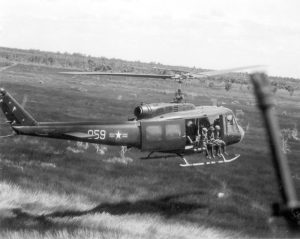
The Bell UH-1 Iroquois helicopter (nicknamed Huey because of its original name, HU-1 for helicopter, utility) first arrived in Vietnam in 1962 and it came to be seen as the iconic symbol of Vietnam to such an extent that it has been memorialized in pop culture from Apocolypse Now to Full Metal Jacket. The Huey was there in the beginning and it was there at the end – airlifting the last Americans out of the embassy in Saigon.
Officially, about 7,000 Hueys were used in Vietnam and nearly half of them were destroyed. But, despite this part of its history, the Huey was considered a lifeline – a symbol of hope in the war-torn jungle. The Huey helicopter carried the “troops, the beans, the bullets” and the mail into Vietnam. The Hueys also carried soldiers off the battlefield. As the documentary tells us, the Huey helicopters brought the hope of getting home again: “You knew when you got on that helicopter, you were in safe hands. You were going to get back, come hell or high water.”

Maloney teamed up with Light Horse Legacy (LHL), a nonprofit focused on supporting veterans with PTS. As LHL says of the veterans they serve: “In a manner of speaking, they are home, but were left behind.” LHL co-founder Paul Barron worked to find a Huey for Maloney’s project. When he did, in 2014 – in a scrapyard in northern Arizona – his organization acquired it, restored it and brought it to Maloney to turn into art.
Healing
The particular Huey that Barron found still had its serial number attached: 67-17174, commonly called #174. From that number, Barron was able to begin a long research project that would tell him more about the story of this particular Huey. He spent countless hours researching what the plane did and who it carried.
While Barron researched the story of #174, Maloney began transforming the helicopter. He worked in a “pop-up” studio composed of a military tent on the grounds of the Palm Springs Air Museum. The beauty of doing it at the air museum in an open-air type setting was that as the sculpture progressed, Maloney could gauge the reaction of his viewers. “I realized,” Maloney said, “that I had one chance to get it right.”
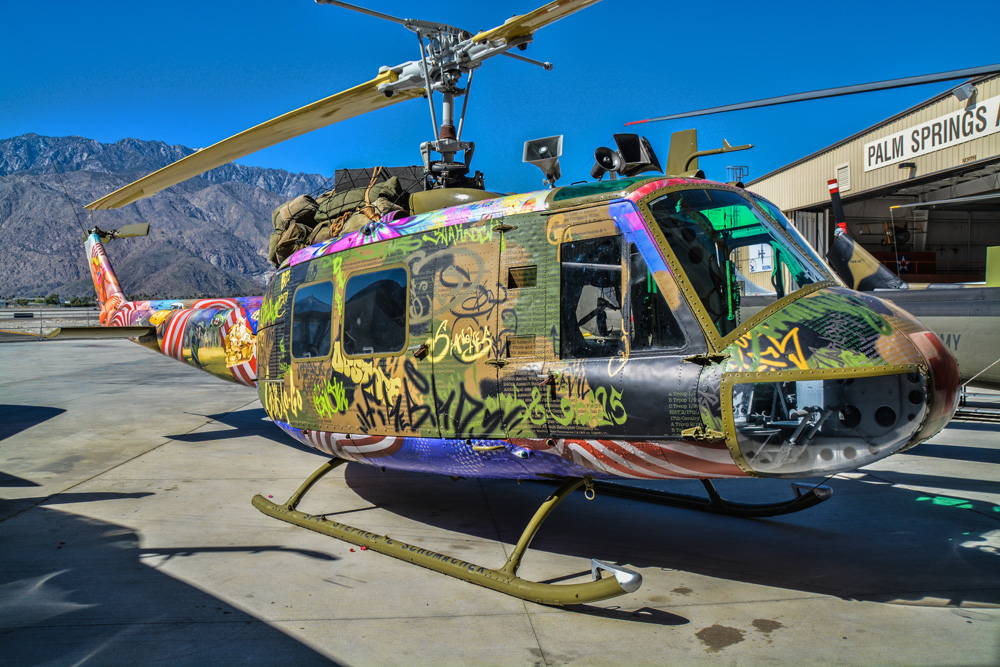
As Maloney was turning the helicopter “from a wounded warbird into a colorful sculpture,” he painted it with pictures of things that he imagined those flying the helicopter might have been thinking about – girlfriends, mom’s apple pie, cars. He also memorialized the aviation unit names and call signs in graffiti form on the side. It was imaginable that veterans might reject it as it was no longer an authentic representation of the military helicopter that it had been or that adding art might be viewed as demonstrating a lack of respect for what it had been. Or, alternately, that the helicopter might churn up unwanted memories in an unhelpful way for those with PTS.
Maloney said the evidence that he was on the right track came over Memorial Day 2014 when he was still working in the tent at the museum. The tent was closed up, but had signage on the outside explaining the project. When he noticed two or three people reading it, he asked if they had served in Vietnam and invited them to come take a look. Maloney said that the experience is often the same: The veteran approaches slowly – maybe apprehensively. As he moves forward, to look in more detail, he inevitably ends up touching the helicopter. And talking. “And they’ll end up saying [after reminiscing], ‘Wow. I’ve never really talked about that before.’”
That is precisely how the healing takes place. The nature of PTS is such that talking helps. As the documentary tells us “when you take a young guy who is twenty years old and has the insanity of combat and you bring him back home and you dump him on the streets, he can’t relate to anybody.” That inability to relate, and the nature of Vietnam having been such an unpopular war, led veterans to bottle it up. But, “living with PTS is like walking a thousand miles with a pebble in your shoe … it never goes away.”
So, Maloney knew, even before the sculpture was finished, that he was on the right track. His project was giving veterans a touchstone and a reason to talk, fulfilling Maloney’s desire for his art to “inspire conversation and lead to taking action.”
#174
Barron found that #174 had served as an air ambulance with the 1st Cavalry Division’s MEDEVAC unit. On February 14, 1969, #174 came under heavy fire as it was attempting to pick up wounded soldiers. The crew members recalled that the helicopter was leaking hydraulic fluid and low on fuel. They banked to the right, trailing smoke. One crew member recalled that just eight weeks earlier they had lost an entire crew of five and seven patients when a similarly wounded helicopter exploded. With smoke billowing from the back of the helicopter and nearby helicopters radioing that they were on fire, the pilot took it down, but crash-landed, crumpling the skid on one side. When two of the crew members, Gary Dubach, the Crew Chief, and Stephen Schumacher, the Medic, jumped out to set up a perimeter (a standard procedure), they were both killed by the rotor blades that had come down lower as a result of the crash land.
Because the serial number was still intact on the Huey that Barron found and because it had been in a crash, the names of those who died in the crash were documented. From there, Barron was able to begin tracking down other crew members. The documentary tells the story of bringing two surviving siblings of Dubach and Schumacher and most of the rest of the crew together, including Ralph Tutrani, the Door Gunner, and Walter McNees, the Aircraft Commander. But, finding the second pilot proved a challenge.
As it happened, the installation was ready and was on exhibit at the National Marine Corps Museum in Washington, DC when the other surviving pilot, Dave Adams, heard a news report about the exhibit of a Huey that had crashed on February 14, 1969 and that one surviving crew member had not been found. He realized that he was the missing pilot. Almost as if on cue, Adams showed up and reunited with Tutrani and McNees and met the surviving sisters of the deceased crew members.

The documentary shows that reunion and the processing of trauma that the installation allowed for the surviving crew members and the sisters. It is a remarkable story of healing the invisible wounds that the war left on those who participated and on their families. As Maloney put it, “[this project] has touched all generations, all genders, all races … When I realized the depth the piece has, well it is the proudest thing I’ve done.”
Huey at the Coronado Island Film Festival
It is especially fitting that Take Me Home Huey will be at the Coronado Island Film Festival over Veterans Day this year. The installation is a poignant memorial to veterans and an honor to those who currently serve. Coronado is home to many of both.
Take Me Home Huey, the sculpture, will be on view at Naval Air Station North Island (NASNI) during the day on Veterans Day as part of the Navy Centennial celebration, for which Jeanie Cunningham will also be serving as Master of Ceremony.
The sculpture will return to NASNI after its showing outside the CoSA theater Saturday evening. It will remain there throughout the week as part of the Navy’s celebration. The documentary will be shown on NASNI on Friday, November 17 at 1:30pm.
Aside from Cunningham, a number of the Take Me Home Huey crew will also be in Coronado over the weekend including the artist, Steve Maloney, and the film-makers, Christine Steele and Alicia Brauns. Additionally, the co-founders of LHL, Dave and Paula Barron will be there, along with Karl Renz III, who has been responsible for pulling the Huey helicopter around the country and who also served as a Door Gunner in Vietnam. None of the surviving members of the crash will be available.




